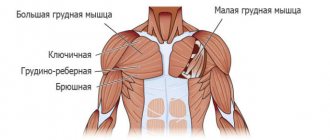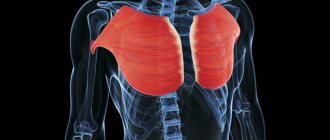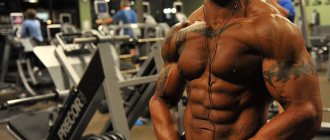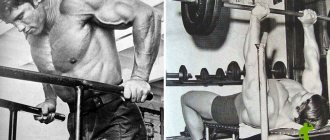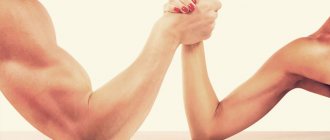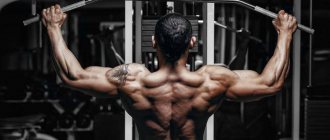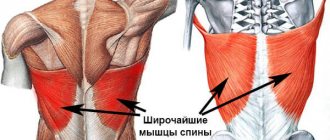Developed pectoral muscles emphasize the overall athletic build. Much in this regard depends on genetics, but it is quite possible to increase their volume.
You need to choose the right exercises, as well as follow general recommendations regarding gaining muscle mass, affecting whole-body training, regimen and nutrition.
It is much easier for men to pump up their chest muscles than for women. Women will not be able to increase the volume of this area through physical exercise, but they will tighten their muscles and tone them.
In any case, a special approach to training and other factors is required.
How to work correctly with the muscles of the sternum with a barbell, dumbbells, and parallel bars
When starting chest development exercises, it is important to understand how to properly load the muscles to get maximum benefit. There are a few tips to follow:
- First of all, perform exercises with a barbell, for example, a bench press or with dumbbells (dumbbell press);
- As auxiliary movements, you can use fly-outs or isolated exercises on simulators;
- to increase volume you need to do 2-4 exercises of 6-15 repetitions. You should not focus on high-repetition movements;
- to develop the chest, a wide and medium grip is used; with a narrow grip, the triceps are more involved in the work;
- parallel bars can be used as a main and auxiliary exercise.
The technique used to perform the exercises will depend on the type of movement. So, for example, the bench press is performed as follows:
- the athlete lies down on the bench so that his eyes are opposite the bar;
- grab the barbell with your hands, wide or medium, evenly from each edge;
- the rod rises from the racks independently or with the help of a belayer;
- first movement - the barbell lowers to the chest while inhaling;
- after a short pause, the projectile rises upward, with a sharp movement with maximum effort, while exhaling;
- the movement is repeated the required number of times.
The dumbbell press is performed in the same way, the only difference is that the dumbbells are either held straight, or their trajectory changes when moving up and down (at the top point they stand “in a row”, and at the bottom they are parallel to each other).
When doing dips, you can either use additional weight or do without it, it all depends on your level of training. The technique is approximately as follows:
- the athlete stands near the bars and climbs on them with outstretched arms;
- first movement - the body lowers as low as possible while inhaling;
- second movement - the body rises as you exhale.
Important! During exercises on the uneven bars, your arms should be kept straight, without allowing vibrations in the area of the elbows. With a wide stance, the load falls more on the pecs, and with a narrow stance, it shifts to the triceps.
At the beginning, it is quite difficult to understand how to do it correctly with a barbell, how to do it correctly with dumbbells and on parallel bars, so it is better to use minimal weights until you fully master the technique. This will ensure minimal risk of injury.
Be sure to watch: “Making” breasts without surgery and diets: exercises for the sternum muscles for women and girls Recommendations on how to pump up a girl’s chest and quickly tidy up a man’s sternum muscles at home Features of chest-back training in one day: an exercise program for beginners and advanced athletes Exercises that will help pump up the sternum muscles for a man
What exercises for home and gym should be included in the program for pumping up the pectoral muscles?
Pumping the chest muscles and working on mass is carried out through a series of exercises. The most popular basic movements when training in the gym are:
- bench press on a horizontal bench;
- incline bench press;
- dumbbell press on a horizontal and inclined bench;
- raising dumbbells on a horizontal and inclined bench;
- presses in simulators;
- dips;
- crossover.
This is the main backbone on which the training program is built.
Breast development at home is done using push-ups. They should be the main exercise. Such exercises are performed according to various schemes, different positions of the arms and legs are combined, and additional weight is used (for example, in a backpack).
You may also be interested in: Chest exercises at home
The structure of the pectoral muscles
The chest is divided into several parts:
- The pectoralis major muscle is the largest. Covers the largest area of the chest. The large muscles of the chest are most adapted to growth.
- The pectoralis minor muscles are located behind the pectoralis major muscles, are less prone to hypertrophy, and when properly developed, give the shape of the breasts.
- Also in the chest there are muscles such as: Serratus anterior, intercostal and diaphragm. These muscles are responsible for adduction; they are not interesting to us from a muscular point of view, since they are not adapted to hypertrophy. We focus on the pectoralis major and minor muscles.
How many times a week should you exercise
When creating a training program, you need to determine how quickly the muscles recover after performing exercises. These processes are individual in nature, some need a week to recover, others need several days. Without going into details of the stages of the process, we can conclude that it is necessary to perform movements on the pectoral muscles once or twice a week.
At the beginning of training, it is best to base yourself on your own feelings. The muscles will ache, this is a normal reaction to training. In case of acute pain, it is not worth repeating the load on the muscle group; it is better to let the body complete the processes.
Main principles of combination
Each person is individual, therefore, for some, 1-3 workouts per week is enough, and for some, 5 sessions are not enough.
There must be moderation in everything. After grueling workouts, muscle fibers and bone tissues must fully rest and recover, otherwise you should not expect obvious progress. It is recommended to include abdominal training at the end of each workout, so exercises for abdominal training will not be noted below in the diagrams. To achieve the desired results, you need to take note of the correct sequence of exercises:
- shoulders;
- pectoral muscles;
- trapezium and neck;
- back extensors;
- biceps;
- triceps;
- legs (in this case we are talking about the buttocks).
Main rules for combining training
Basic rules for combining training developed by professional athletes:
- During one workout, you can work out the biceps and triceps muscle tissue along with the triceps.
- Abdominal exercises can be combined with all groups, so it is recommended to leave it “for a snack” at the end of each workout.
Working out the pectoral muscles and triceps in one day gives good results.
Technical training of the pectoral muscles and triceps in one day will allow you to quickly see good results. It is also recommended to combine training of biceps and deltoids with triceps.- It is not recommended to pump your shoulders together with the pectoral groups, since during training the deltoids will be very tired, especially the front ones. This combination must be excluded in the training process: the tissues will be overstrained and their growth will not be observed.
- A day of biceps and back training can be combined with forearm training. They are rarely indicated in the diagrams, since according to statistics, no more than 5% of all gym visitors use them.
- If you combine training of triceps and biceps with any other group, they must be moved to the very end of the training process, since hammering your arms will not allow you to effectively work out all the other muscle fibers, for example, the chest or back. The only exception is that the entire workout is devoted exclusively to the arms.
Program for pumping the muscles of the sternum
Training should be based on a scheme, that is, a training program. The plan is drawn up at the beginning of classes and adjusted based on your own feelings, progress, recovery speed and other factors.
The plan will be different for beginners and more experienced athletes. At first, it is recommended to perform fewer exercises, giving preference to basic, multi-joint movements. Then the isolated ones are included, and other diversity is introduced.
For newbies
When we pump our chest, other muscles come into play. This factor must be taken into account when creating a training program. For beginners, it is better to train according to the principle of a three-day split, focusing each workout on two or three muscles.
A sample plan looks like this:
| Workout 1 | Legs and shoulders. 2-3 leg exercises (for example, squats, lunges and machine leg presses), then 2 shoulder exercises (standing barbell press and seated dumbbell press) for 3-4 sets of 6-12 reps. |
| Workout 2 | Chest and triceps. Bench press 4 sets of 8-15 reps. Incline dumbbell press, 3 sets of 8-15 reps. Dumbbell flyes, 3 sets of 10-12 reps. Triceps on the block, 4 sets of 10-15 reps. Dips, 4 sets of 10-12 reps. |
| Workout 3 | Back and biceps. Option: deadlift, barbell row, pull-up, biceps curl, dumbbell curl on a Scott bench. 3-4 sets of 6-12 repetitions. |
Training can be alternated differently. For example, the pecs can be combined with the back, shoulders, and so on. The main thing is that the body has time to recover. Before pumping the lower chest separately (or the upper), it is worth paying attention to the overall development, then the weaknesses will become clear, and the program will change depending on them.
For advanced
More experienced athletes can pay more attention not to general training, but to individual parts of the pectoral, isolating movements. But before training the lower part of the sternum muscles or, conversely, the upper part, it is worth performing basic exercises, only then moving on to special movements.
A chest/triceps training day might look like this:
- bench press, 4 sets of 10-12 reps;
- dumbbell press, 3 sets of 10-15 reps;
- Incline bench press, 3 sets of 12-15 reps;
- crossover, 3 sets of 12-15 reps;
- French press, 4 sets of 12 reps;
- bent over triceps extension, 3 sets of 10-12 reps.
Another training option for combining the load on the chest and shoulders is as follows:
- bench press with a barbell, 4 x 10;
- Smith machine press, 3 x 10;
- crossover, 3 to 12;
- dumbbell flyes, 3 to 12;
- standing barbell press, 4 x 12;
- Arnold press, 4 to 12-15.
There are quite a lot of options. For example, a five-day split can be used, when training is carried out 5 times a week, then a separate day is devoted to the chest, approximately 5-6 movements are performed.
You may also be interested in: How many times a week should you exercise?
Does it make a difference which muscles to train together?
Muscle Groups in Bodybuilding
Each muscle group is designed to perform specific tasks. For example, one half of the muscle is designed to push and the other half is designed to pull. This follows the standard division:
- pulling muscle tissue - biceps and back;
- pushing muscle groups - triceps, shoulders and chest.
Next are the legs, which include the calves, quads, and hamstrings. Each group consists of individual muscles, which together ensure the full functioning of the body and the movement of a person in space.
This division is quite superficial, but it allows you to understand which tissues are recommended to be trained on the same day. For high-quality development of the pectoral and other muscles, one condition must be fulfilled - technical and regular performance of isolation exercises.
It is recommended to give preference to basic exercises if you want to gain muscle mass. Core training naturally targets a large number of muscle fibers at once.
How to quickly develop muscles: pro tips
The development of chest muscles requires a special approach. Progress can be achieved both at home and in the gym, but, according to professionals, a program for pumping up these muscles should preferably contain exercises with a barbell and dumbbells.
Professionals, especially coaches and experienced athletes, advise starting movements with heavy exercises that affect the chest as a whole and do not focus on any part. This is a barbell press, dumbbells, parallel bars, and in home exercises - push-ups. For women, it is better to do incline presses to develop the upper chest, which will allow it to “tighten” it somewhat.
Important! According to the pros, it is better to complete classes with isolating movements, which will help consolidate the result. Also, do not forget about the restoration of the body, which is carried out through proper nutrition and adherence to the regime.
Alexander Kodzoev, bodybuilder
A well-known bodybuilder in Russia uses a five-day split program, devoting a separate day to the chest. Depending on the season, either heavy multi-joint exercises or isolation exercises can be performed on this muscle group.
He advises non-professionals to focus on presses, as they will allow you to work the chest as a whole and only then move on to isolated movements. It is also worth correctly distributing the load, training the body as a whole, comprehensively and harmoniously, and not focusing only on chest training.
Dmitry Yashankin, bodybuilder
Dmitry Yashankin is known not only for his professional career, but also as the author of many training videos and techniques. He advises approaching body training consistently, taking into account the characteristics of the body, strengths and weaknesses. But in any case, you need to train the entire body.
In his opinion, it is better to train the chest with bench presses, then move on to movements on machines and other auxiliary exercises. For beginners, it is better to perform 2-3 exercises and allow the body to recover well, only strengthening the program over time.
Ekaterina Usmanova, fitness bikini
The athlete not only competed in fitness bikini, but also successfully participated in bench press competitions. She believes that even girls should do bench presses, as it will help harmoniously develop muscles and tighten their chest. Particular attention should be paid to the bench press of barbells and dumbbells on an incline bench, but also include fly-outs and movements on machines in the program.
Main conclusions
You need to train your chest consistently and in a variety of ways. It is necessary to provide the body with a load adequate to the level of training, and it should increase over time, gradually. It is best to choose basic, heavy movements, especially at the beginning of training.
The best exercises for chest development are considered to be the bench press, both barbells and dumbbells, as well as flyes, dips and a whole range of exercises on machines. Don’t forget about training the muscles that are auxiliary for chest movements, such as the back, triceps, abs and shoulders.
